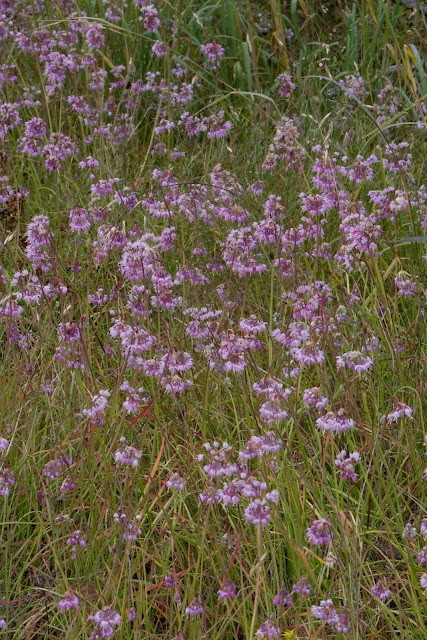With the summer solstice just a couple days away, spring's wildflower season gives way to the flowers of summer. Of course some species overlap both season's unconcerned about the calendar. The yellows of mid to late spring, broadleaf stonecrop (
Sedum spathulifolium) and woolly sunflower (aka Oregon sunshine) (
Eriophyllum lanatum) fade into another round of yellows: Puget Sound gumweed (
Grindelia integrifolia) and lance-leaf stonecrop (
Sedum lanceolatum). Amazingly several western buttercups (
Ranunculus occidentalis), first blooming in March, are still in flower although I have already collected some buttercup seed.
 |
| Broadleaf stonecrop (lower left) and woolley sunflower |
 |
Puget Sound gumweed
|
 |
| Lanceleaf stonecrop |
Likewise, another March bloomer, harsh paintbrush (
Castilleja hispida), still offers patches of bright red on the north side. But the main colors joining the yellows are the pinkish purples of the two onions, Hooker's onion (
Allium acuminatum) and nodding onion (
A. cernuum)
 |
| Hooker's onion |
 |
| Nodding onion |
 |
| Nodding onion |
plus the another shade of purple from harvest Brodiaea (
Brodiaea coronaria)
and fireweed's (
Chamerion angustifolium) deep bright pink.
 |
| Harvest Brodiaea |
 |
| Fireweed |
Clustered (or California) broomrape (
Orobanche californica) is very rare but also part of this color scheme.
 |
| Clustered broomrape |
Even yarrow (
Achillea millefolium) has a pink version but the white is far more common.
 |
| Yarrow (light pink form) |
 |
| Yarrow (white form) and nodding onion |
A few white flowers from spring can still be found if you look closely. Western starflower (
Trientalis latifolia) and field chickweed (
Cerastium arvense) add spots of white here and there. The white flowered serviceberry is forming berries and its white flowers are replaced by the native shrub oceanspray (
Holodiscus discolor).
 |
| White-crowned sparrow atop oceanspray. |
Even the beach areas offer bits of color. Sea rocket (
Cakile edentula, native, and
C. maritima, non-naitive) offer a pale purple hue to the high intertidal
 |
| Cakile maritima |
 |
| Cakile edentula |
while Japanese beach pea (
Lathyrus japonicus) shows off its bicolored purple.
 |
| Japanese beach pea |
Do these represent the end the end of the flowering season? Not quite. Two species that have yet to bloom are brittle prickly pear cactus (
Opuntia fragilis) and seaside rein orchid (
Piperia elegans).
My plan had been to walk around today photographing all these species but alas it has been raining the past couple days. All the above photos are file photos from previous years.















No comments:
Post a Comment